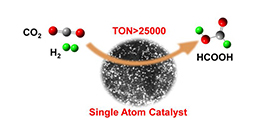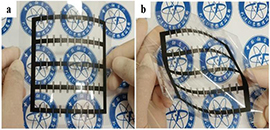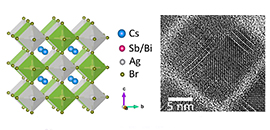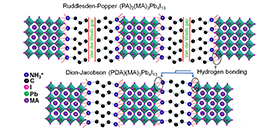Research News
-
 01 28, 2019Single-Atom Catalyst Based on Homogeneous Catalysis Prototype for CO2 Transformation DevelopedHUANG Yanqiang and colleagues in Prof. ZHANG Tao's research group at the Dalian Institute of Chemical Physics (DICP) of the Chinese Academy of Sciences recently developed a strategy to rationally design a single-atom catalyst for applications.
01 28, 2019Single-Atom Catalyst Based on Homogeneous Catalysis Prototype for CO2 Transformation DevelopedHUANG Yanqiang and colleagues in Prof. ZHANG Tao's research group at the Dalian Institute of Chemical Physics (DICP) of the Chinese Academy of Sciences recently developed a strategy to rationally design a single-atom catalyst for applications.
Single-atom catalysts (SACs) with atomically dispersed active metal centers on supports represent an intermediary between heterogeneous and homogeneous catalysis. Therefore, understanding the homogeneous catalysis prototype creates a great opportunity for designing SACs and developing related applications.
HUANG Yanqiang and colleagues in Prof. ZHANG Tao's research group at the Dalian Institute of Chemical Physics (DICP) of the Chinese Academy of Sciences recently developed a strategy to rationally design a single-atom catalyst for applications. The method involves creating single-atom active sites on supports based on homologous homogeneous prototypes. This process ensures the stability of the active sites and also preserves catalytic capability during the corresponding homogeneous processes.
The strategy is exemplified in the Ir-based catalysts for the catalytic transformation of CO2 to formate. The support in an SAC is similar to the ligands of a mononuclear metal complex in homogeneous catalysis. The surface atomic structure of the support behaves like a "chelator" of organic complexes toward single atom metal centers, and this function is directly related to the chemical bonding and electronic state of the active metal sites.
Accordingly, the design of a support having electron-donating functional groups, which imitates a mononuclear Ir pincer complex, is a key factor in the development of an Ir-based SAC for the catalytic transformation of CO2 to formate.
By developing a porous organic polymer with aminopyridine functionalities to construct Ir single-atom active sites analogous to the mononuclear Ir complexes (Fig. 1), this material exhibits superior activity relative to conventional nanoparticle catalysts during the hydrogenation of CO2 to formate under mild conditions. This represents the best performance yet for a heterogeneous conversion of CO2 to formate, while maintaining outstanding stability upon recycling.
Meanwhile, a catalytic mechanism similar to that over a homogeneous Ir catalyst was observed with this quasi-homogeneous Ir-based SAC. The present strategy provides a promising basis for the design of efficient SACs for use in present-day homogeneous chemical conversions, and serves to illustrate potential bridging between homogeneous and heterogeneous catalysis.
Fig. 1 A porous organic polymer with aminopyridine functionalities with Ir single atom active sites analogous to the mononuclear Ir pincer complexes was demonstrated. (Image by DICP)
Published in Chem, this work was supported by the National Key R&D Program of China, the Strategic Priority Research Program of the Chinese Academy of Sciences, and the National Natural Science Foundation of China. (Text by DICP) -
 01 23, 2019Multitasking Graphene Ink Printed into Tiny Flexible Supercapacitors
01 23, 2019Multitasking Graphene Ink Printed into Tiny Flexible Supercapacitors
Screen-printed devices show strength in numbers
Researchers in China have developed an easy way to make complicated arrays of microsupercapacitors that involves screen-printing them out of graphene ink. The simplicity and freedom offered by the approach will aid the development of new approaches to electronics and flexible devices.
Although semiconductor components continue to shrink, not all of the parts of modern gadgets are as easy to miniaturise. Capacitors and batteries are particularly challenging given that they are complex and discrete bundles of different materials. Microsupercapacitors, a tiny relative of both of these components, can do similar jobs.
Now, scientists at the Chinese Academy of Sciences have come up with a screen-printing method using a multi-purpose graphene ink that quickly lays down multiple microsupercapacitors in a variety of shapes and as complicated arrays. The ink combines graphene and carbon black, both of which are conductive, with a polymer binder in a solvent, although the simplicity of the mixture belies the difficulty in finding the right composition. ‘Preparing inks with suitable electrical, electrochemical and rheological properties was one of the biggest challenges for printable integrated microsupercapacitors,’ emphasises Zhong-Shuai Wu, one of the principal investigators on the project. Importantly, the ink shows shear-thinning behaviour, like ketchup: as it’s applied, the force causes it to lose its viscosity so it flows easily, but as soon as the force is removed, it thickens and keeps its shape.
They applied the graphene ink to a substrate, such as glass or flexible PET plastic, using a patterned screen as a stencil. The resulting pattern includes all of the conductive parts of the device. ‘The graphene-based ink can act as the microelectrodes, metal-free current collectors and interconnects, simultaneously,’ Wu notes. The ink dries for 12 hours, and then an electrolyte gel is applied and allowed to solidify for a further 12 hours, at which point the device is ready to use.
Because the entire structure of the device can be laid out in one step, very complicated designs can be made with ease. Although a single microsupercapacitor supplies less than one volt, the researchers were able to integrate 130 of them in series, giving an output of over 100 volts. ‘Micro-robots and soft actuators based on dielectric elastomer require hundreds and even thousands of volts,’ says Wu. ‘High voltage operation increases the scope and usefulness of microsupercapacitors,’ agrees Francesca Iacopi, head of the integrated nanosystems lab at the University of Technology Sydney in Australia.
The supercapacitors are incredibly flexible. (Image by Royal Society of Chemistry)
The devices are also flexible, if they’re printed on a flexible substrate, which should make them compatible with wearable electronics. ‘The versatility and low cost of this screen-print approach could be a plus in the wearable systems that are disposable, which is what most of the external health monitoring and other wearable systems are meant to be,’ says Iacopi. ‘I believe microsupercapacitors on flexible substrates like these would be particularly promising to support the area of wearable systems for health monitoring, for example sensors placed on skin and eyes.’
The investigators are keen use their method to make more complete devices, by including components that can harvest energy and store it in the microsupercapacitors, or put that stored energy to use. They also hope to use new electrolytes to increase the voltage each capacitor can provide, and improve the total energy a device can store. (Chemistry World) -
01 09, 2019Catalytically, is copper the new gold?Approach for depositing copper on silica support influences how easily it oxidises, and in turn the reactions it catalyses
Approach for depositing copper on silica support influences how easily it oxidises, and in turn the reactions it catalyses
Researchers in China claim that they have changed the chemical properties affecting a copper catalyst’s electronic structure, making it more like gold or silver. The team, led by Jian Sun from Dalian Institute of Chemical Physics, Chinese Academy of Sciences, has devised a new approach to making catalysts that yield useful organic molecules from coal.
‘We observed the possibility of changing the electronic structure of a copper atom by external energy, which will make copper exhibit a noble metal-like chemical property,’ Sun tells Chemistry World.
High energy plasma excited the unique electron configuration of copper and altered its chemical properties. (Image by SUN Jian and YU Jiafeng)
Reacting carbon monoxide produced by burning coal with methyl nitrite can make dimethyl oxalate. Catalytically hydrogenating dimethyl oxalate can make a variety of products, with the outcome depending on how the catalyst used is prepared, explains team member Xiaoxuan Wei, from Zhejiang Normal University. Silica-supported copper is one of the catalysts that has been studied for this process but tends to oxidise, forming copper ions, more easily than silver or gold. This chemical property depends on the electronic structure of the copper atoms in the catalyst, Sun adds.
Previously, Chinese scientists had coated copper onto silica particles by dissolving copper salts in a mixture of water and ammonia, and then heated it to evaporate the ammonia. But Sun and their colleagues used a gas-phase sputtering approach, ejecting individual copper atoms from a sheet of the pure metal using high-energy argon plasma. The copper atoms then coat silica particles inside a hexagonal rotating chamber that the team made themselves. ‘The support powders are stirred by the rotating hexagonal barrel,’ Sun explains, meaning that copper coats the silica particles evenly, forming ‘clusters or nanoparticles’.
Sputtering a copper coating onto silica creates catalysts that behave more like noble metals than similar catalysts produced through a solution-phase ammonia evaporation method. (image by DICP, CAS)
X-ray diffraction analysis indicates that catalysts produced by ammonia evaporation are copper phyllosilicates. By contrast, sputtering produces pure copper metal layers. Different x-ray spectroscopy approaches also show that it’s harder for the outermost electrons of sputtered copper atoms to escape. The resulting copper nanoparticles are therefore harder to oxidise. When the chemists use the sputtered catalyst in dimethyl oxalate hydrogenation, it predominantly makes methyl glycolate. That’s a significant change from the ammonia evaporation catalyst, which predominantly makes ethylene glycol, thanks to the involvement of copper ions.
Inorganic chemist Andrew Beale, of University College London, UK, says the study ‘does a pretty good job of experimenting with an unconventional catalyst preparation method and then tries to rationalise an unexpected enhancement in performance’. The approach ‘could conceivably be scaled if the observed effects translate to other catalytic materials’, he adds. (Chemistry World) -
 12 31, 20182019 New Year’s Message from the Director
12 31, 20182019 New Year’s Message from the Director
-
 12 27, 2018Scientists Develop New Lead-Free Double Perovskite NanocrystalsA research team led by HAN Keli from the Dalian Institute of Chemical Physics (DICP) of the Chinese Academy of Sciences synthesized new lead-free double perovskite nanocrystals (NCs). The detailed charge carrier dynamics of these NCs were also clarified.
12 27, 2018Scientists Develop New Lead-Free Double Perovskite NanocrystalsA research team led by HAN Keli from the Dalian Institute of Chemical Physics (DICP) of the Chinese Academy of Sciences synthesized new lead-free double perovskite nanocrystals (NCs). The detailed charge carrier dynamics of these NCs were also clarified.
A research team led by HAN Keli from the Dalian Institute of Chemical Physics (DICP) of the Chinese Academy of Sciences synthesized new lead-free double perovskite nanocrystals (NCs). The detailed charge carrier dynamics of these NCs were also clarified. Their findings were published in Angew. Chem. Int. Ed..
The structure of double perovskite has a general chemical formula of A2MM'X6 (where A is a monovalent cation, X is the halogen anion, M and M' are +1 and +3 cations).
Although, the double perovskite family consists of several thousand combinations from a theoretical perspective, only a few bulk materials have been synthesized experimentally. Among these, only two families of double perovskite colloidal NCs namely, Cs2AgBiX6 (X = Cl, Br, I) and Cs2AgInCl6 (Mn2+ doped Cs2AgInCl6) have been prepared. On the other hand, the charge carrier dynamics of double perovskite NCs are still not clear.
Crystal structure and charge carrier dynamics of Cs2AgSb1-yBiyBr6(0 ≤y ≤ 1)) (Image by YANG Bin)
The scientists synthesized a series of lead-free double perovskite NCs: Cs2AgSb1-yBiyX6 (X: Br, Cl; 0≤y≤1) NCs. In particular, Cs2AgSbBr6 NCs is a new double perovskite material that has not been reported for the bulk form. Mixed Ag-Sb/Bi NCs exhibit enhanced stability in colloidal solution compared to Ag-Bi or Ag-Sb NCs.
Femtosecond transient absorption studies indicate the presence of two prominent fast trapping processes in the charge carrier relaxation. The two fast trapping processes were dominated by intrinsic self-trapping (1~2 ps) due to giant exciton-phonon coupling and surface defects trapping (50~100 ps), respectively.
In this work, the slow hot-carrier relaxation is observed at high pump fluence, and the possible mechanisms for the slow hot-carrier relaxation are also discussed.
This study was supported by the key research project of National Natural Science Foundation.(Text by YANG Bin) -
 12 22, 2018Stabilizing 2D Layered Perovskites for Photovoltaics: Setting Up a Defensive Wall
12 22, 2018Stabilizing 2D Layered Perovskites for Photovoltaics: Setting Up a Defensive Wall
How to set up a defensive wall in a soccer game? No coach likes a gap between defensive players in the wall. Scientists are doing the same when they try to improve the stability of perovskite solar cells (PSCs).
A research team, led by Prof. GUO Xin and Prof. LI Can from the Dalian Institute of Chemical Physics (DICP) of the Chinese Academy of Sciences (CAS), improved the stability of PSCs by removing the gaps, called van der Waals gaps, in widely studied Ruddlesden-Popper (RP) phase two-dimensional (2D) layered perovskite materials.
The newly developed materials are a series of Dion-Jacobson (DJ) phase 2D layered perovskites which, without gaps, have an extremely stable structure and can defend against attacks from moisture, heat and light more efficiently, leading to outstanding stability of PSCs under various harsh testing conditions. The team's findings were published in Joule on Dec 21.
Comparison of RP and DJ phase 2D layered perovskite structures. (Image by GUO Xin)
PSCs have shown great promise as a candidate for next-generation photovoltaics. However, their instability limits further development because of the poor structural stability of conventional organic-inorganic hybrid perovskites (3D ones), which are usually used as the light-harvesting materials in PSCs.
The 2D layered perovskites have attracted a lot research interest in recent years because they offer better stability than traditional 3D analogues. In most cases, the term "2D layered perovskites" refers to RP phase ones, in which van der Waals gaps are present. These gaps create weak interactions between layers, thus lessening the stability of the layered perovskite structure and the device.
"In contrast with the RP case, our DJ phase 2D layered perovskites are formed by alternating hydrogen bonds between organic layers and inorganic layers with no gaps, which makes their structure more stable," said Prof. GUO.
"External stresses like moisture, heat and light cannot easily degrade such materials. This is just like a defensive wall in a soccer game. Imagine that each defensive player is an organic layer or an inorganic layer in 2D layered perovskites. If they stand next to each other in a row, the kicker cannot easily make a goal. If there are gaps between players in the wall, the kicker can score easily, which is just like the situation in RP 2D layered perovskites," GUO explained.
More energy from external stresses is needed to degrade DJ phase 2D perovskites than their RP counterparts. As in a soccer game, a banana kick has to be made to bypass a good defensive wall, so it is more difficult for the kicker.
"Indeed, the PSCs fabricated using our materials exhibited more outstanding stability than those using 3D and RP phase 2D perovskites," said Prof. LI. "Our unsealed devices can maintain 95% of initial efficiency upon exposure to various harsh stresses, including being stored in ambient air for 4,000 hours, heated at 85 °C with relative humidity of 85% for 168 hours, and continuously illuminated for 3,000 hours."
"The highest efficiency we obtained from the PSCs made from our 2D perovskites is just over 13%. Although this is one of the highest values among 2D PSCs, it lags behind the state-of-the-art efficiency of 3D PSCs. Therefore, more effort needs to be made to further improve the efficiency of these 2D PSCs," the DICP researchers said in their report.(Text by GUO Xin)